New variety of edible honeysuckle Aurora
The Aurora variety is a honeysuckle with very large fruits. Berries are appreciated not only for their attractive appearance and taste, but also for their medicinal properties. Farmers cultivate this variety commercially. Summer residents can also grow Aurora on their site, and we will tell you how to do this in this article.
The content of the article
Description of the variety of honeysuckle Aurora
Honeysuckle is an early horticultural crop, as the former forms fruit. Aurora will delight the gardener with delicious berries in mid-June. However, the variety has its own characteristics, advantages and disadvantages.
Origin and development
The variety was developed by Maxine at the University of Saskatchewan. The work began in Canada in 2007 and finished in 2016. Aurora belongs to the new varieties of edible honeysuckle.
It was obtained by crossing the Russian variety Nightingale with the Japanese MT 46.55. Breeding work was carried out within the framework of the Thompson breeding program. Honeysuckle is actively grown in Russia and neighboring countries.
Description of appearance and taste
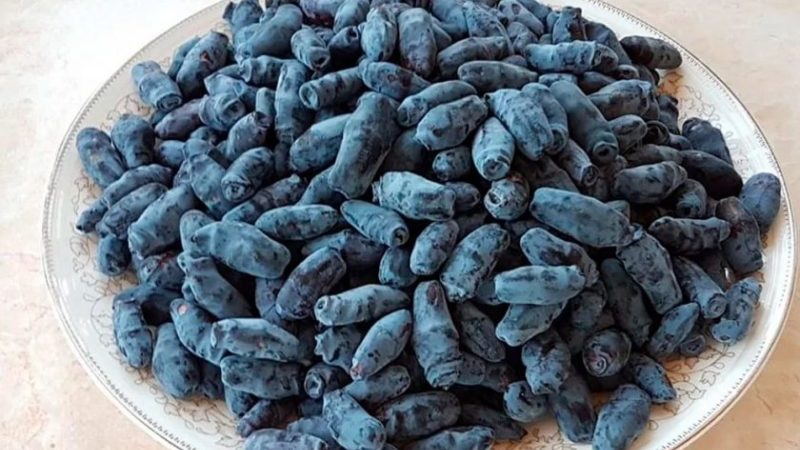
Aurora's typical destination is an alley landing. It looks good in a group with other varieties, as it forms a compact bush with a neat crown.
Description of the Aurora honeysuckle variety:
- The bush is 1.8 m high and consists of 10-15 inclined shoots. Belongs to deciduous and evergreen types. The crown diameter is 1.3 m.
- Annual shoots, characterized by medium vigor, minimally pubescent.
- The bark has a range of shades from dark to reddish brown.
- The leaves are elongated, reaching a length of 10 cm. The lower part has rare pubescence. The upper is colored from moderate to dark green.
- Flowering begins in mid to late April. Small yellow flowers are evenly distributed along the entire length of the shoot. The scent appears in the late afternoon, as night moths play the role of pollinators.
- The berries are narrow-oblong, with a small eye, without pubescence. The peel is slightly rough, blue. The intensity of the shade depends on the brightness of the sun's rays: the more illuminated the area, the darker the berries. The weight of one fruit reaches 2 g.
A brief description of Aurora's needs:
- USDA zones (cold resistance) - 9-4;
- lighting - preferably sun or partial shade;
- soil acidity - slightly alkaline, neutral, slightly acidic;
- soil - moderately moist, with drainage, fertile;
- drought resistance - high;
- disease is rare.
Ripe berries are very sweet, but there is a slight bitterness and a hint of astringency.
Application features
Aurora variety - edible honeysuckle. Its berries are used to make preserves, jams, homemade ice cream. Many people prefer to consume the fruits fresh.
Productivity and fruiting
The berries begin to ripen in early June. Fruiting early and long, the fruits are harvested as they ripen. After planting in a new place, the shrub begins to bear fruit for 3 years.
The producer did not indicate the total yield of the plant Gardeners in their reviews claim that up to 2 kg of berries are harvested from one bush.
Ripening period
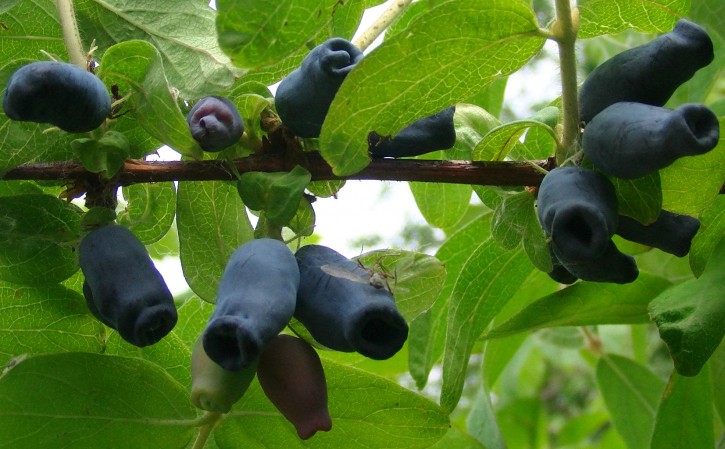
Honeysuckle Aurora belongs to the early maturing varieties. Flowering begins in mid-April and fruiting in June.
Disease and pest resistance
Honeysuckle is affected by fungal diseases: ramulariasis, cercosporosis, powdery mildew, and turbeculariasis.
The main pests: Californian scale insect, aphids, honeysuckle mites, leafworms, honeysuckle fingerfly, mealybug.
Cold and drought resistant
Aurora can withstand frosts down to -45 ° C. Drought resistance is above average, so the shrub does not need abundant and regular watering.
Growing regions
The variety is grown in the middle lane and northern regions of Russia. Honeysuckle is not demanding on growing conditions, so it is easy to care for it.
Advantages and disadvantages
Main advantages:
- early ripening;
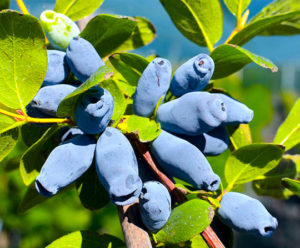
- large berry sizes;
- good resistance to drought and cold;
- undemanding care;
- the formation of a neat bush;
- a good option for creating a berry, alley.
Disadvantages:
- weak immunity;
- requires more space for the normal development of the bush.
Difference from other varieties and hybrids
The bush is pollinated by night moths. Other differences: elongated leaves, no pubescence at the top of the berries.
Agrotechnics
There are no particular difficulties in planting and growing Aurora honeysuckle. To get a good harvest, it is important to choose the right planting site, prepare the planting material and follow the rules of care.
Choosing a place in the garden and preparing holes
The plant loves well-drained soil and an abundance of sunlight. When preparing the holes, a gap of 1-1.5 m is left between future plants.
Prepare the holes as follows:
- The site is dug up, earth clods are broken, stones and grass are removed.
- Dig a hole 50 cm deep and up to 60 cm wide.
- 2 buckets of compost or rotted manure are added to each pit.
- A layer of earth is laid on top.
- Add 3 tbsp. l. superphosphate and 1 liter of wood ash.
Works are performed on a sunny day at temperatures from + 15 ° C. The ground temperature should be from + 10 ° C, and the humidity should be at least 80%.
Important! A trellis or trellis is installed near each hole for the stability of the seedling. Mount it before planting, otherwise the risk of damage to the root system increases.
Preparing for landing
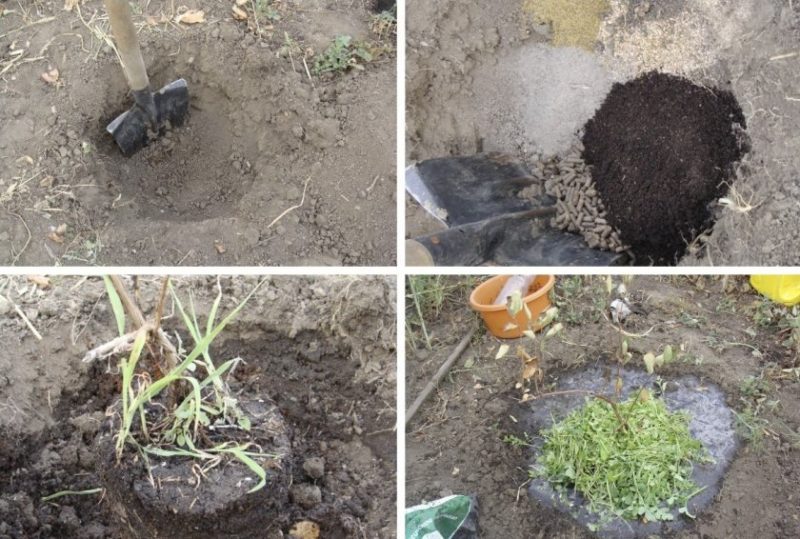
Before planting, the planting material is selected and prepared. Buy seedlings in the nursery. High-quality honeysuckle meets the following characteristics:
- age - 2 years;
- the presence of 2 or 4 straight shoots without any damage;
- the presence of developed buds on the shoots is mandatory;
- the length of each shoot is about 60 cm;
- the presence of a healthy and fibrous root system, including 2 thick roots and several small ones.
Before planting in the ground, the seedlings are taken out into fresh air. Enough 7 days for good hardening. Before planting, the root system is immersed in a weak solution of potassium permanganate, then in the growth stimulator "Kornevin".
Read also:
Ground requirements
The soil is chosen loamy or sandy loam. It permeates oxygen and moisture better, contains a large amount of nutrients. The acidity of the soil is not higher than 5-6 pH.
Timing, scheme and landing rules

In areas with warm winters, honeysuckle is planted in mid-October. In the northern regions, planting work is carried out in late April or early May.
Planting honeysuckle looks like this:
- A seedling is placed in a pre-prepared hole.
- The top of the pit is covered with earth and compacted for plant stability.
- Pour 2 buckets of water.
- If necessary, fill up the soil.
Honeysuckle belongs to shrubs, so it is more convenient to plant it in rows. Near them, one common support is installed, to which the bushes are then tied.
Growing features
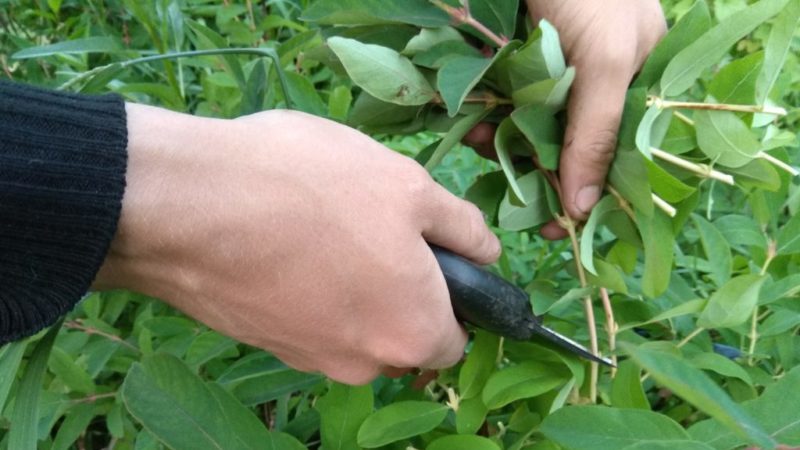
Honeysuckle requires timely watering, pruning, feeding. If the following nuances of care are not followed, the plant will get sick, it will be attacked by insects.
Main works:
- Watering. A young plant is watered 2-3 times a week. After a year - once a week. 2 buckets of clean water are poured under the bush.
- Soil cultivation. Weeds are removed around the honeysuckle, the soil is loosened after each watering. Lay a layer of mulch from sawdust, wood chips, straw, pine needles or fabric material.
- Pruning. At the end of April, weak branches are completely removed. Make sure that the inventory is clean and disinfected.
- Top dressing. The bush is not fertilized for 1 year. Then, in the spring, they are fed with a mixture of 20 g of ammonium nitrate, 20 g of potassium fertilizer and 20 g of superphosphate per 1 sq. m. In the fall - 5 kg of compost, 40 g of superphosphate and 100 g of ash per 1 sq. m. 500 g of fertilizer is applied under each bush.
Pollinators
Honeysuckle Aurora is a self-pollinated variety, as it forms bisexual flowers. But experienced gardeners recommend alternating this plant with 2-3 other varieties to increase yields.
Good pollinators: Tundra, Honey Bee, Borealis, Blue Velvet and Tomichka.
Disease and pest control
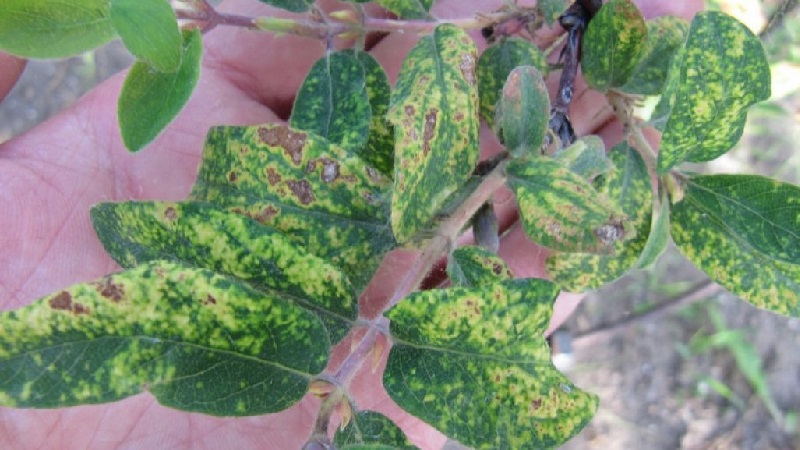
Major diseases:
- Ramulariasis. Signs: brown spots on the leaves, wilted green mass. The affected areas are removed and destroyed, the bush is sprayed with a 0.5% solution of copper sulfate.
- Cercosporosis. Dark green spots appear with a dark border on the leaves. Honeysuckle is treated with 1% Bordeaux liquid solution.
- Powdery mildew. Sign - gray bloom on the leaves. The bushes are sprayed with a 2% solution of colloidal sulfur.
- Tuberculariosis. Red bumps form on leaves and stems. The plant is treated with Bordeaux liquid.
- Mosaic. Sign - large white spots on the leaf plates. The affected areas are removed and destroyed. It is useless to treat the shrub.
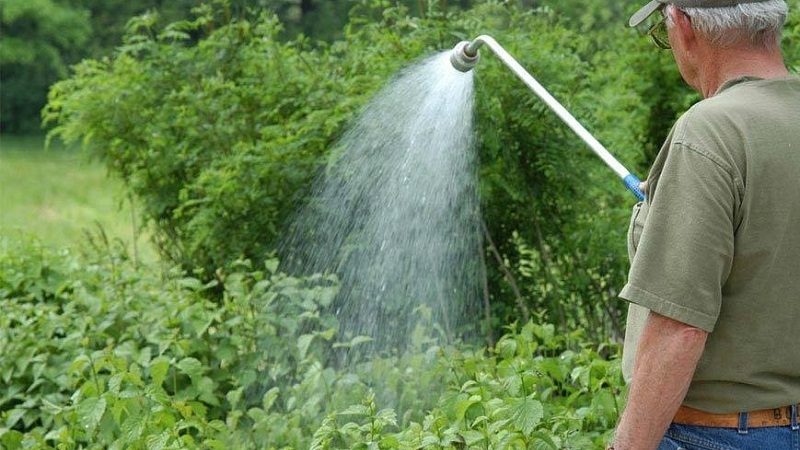
Pests:
- California scale insect. Reddish spots and gray scales are visible on the shoots. The bushes are sprayed with Aktara and Aktellik. Adults are collected in a container and destroyed.
- Aphid. A sticky coating appears on the leaves, they are deformed and turn yellow. Aphids are destroyed by spraying honeysuckle with soapy water. Recipe: 100 g of laundry soap is diluted in 5 liters of warm water.
- Honeysuckle mite. Leaves curl, fall off. The plant is treated with "Aktellik" after the end of fruiting, at the end of June.
- Leaf roll. A cobweb inside the leaf and green caterpillars appear. The bushes are sprayed with Aktara.
- Honeysuckle fingerfly. Signs: eaten foliage, spoiled berries. The plant is treated with "Rogor" or "Inta-Vir".
- Mealybug. Shoots and leaves wither. The bushes are sprayed with Aktellik or Rogor.
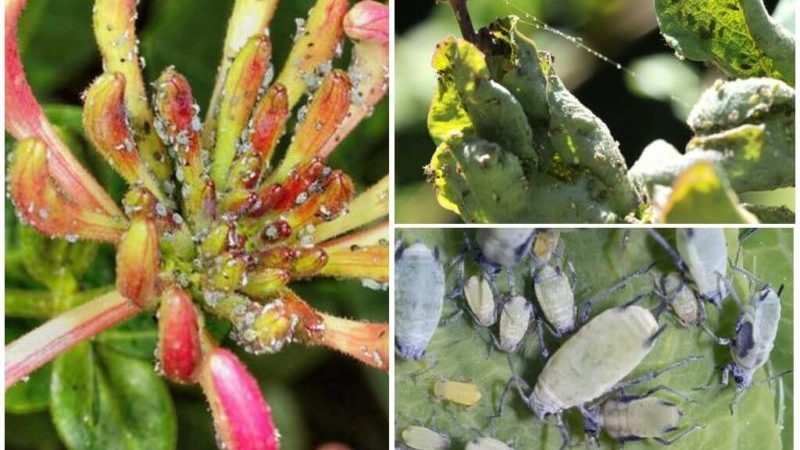
Preparing for winter
Honeysuckle Aurora does not require shelter for the winter. But experienced gardeners, before the onset of cold weather, perform autumn work:
- weeding;
- digging up the soil;
- removing mulch;
- alignment of the hole with the common ground plane;
- destruction of fallen leaves;
- spraying with 1% Bordeaux liquid solution.
If the shrub was tied to a support, it is removed. Place a net around the plants so that mice and hares do not damage them.
Reproduction
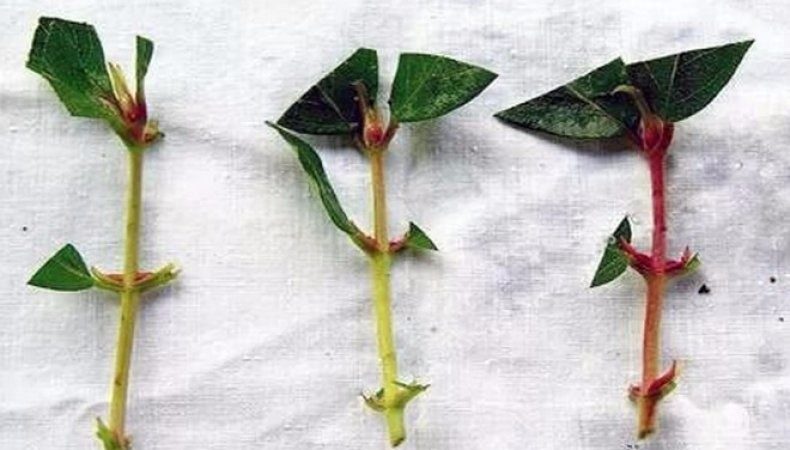
Experienced gardeners consider methods for dividing roots and propagating root layers to be ineffective, since new plants do not take root.
The preferred method of grafting:
- In the fall, a strong shoot is cut off and divided into 3 parts up to 15 cm long.
- Make sure that 2 kidneys are present on each part.
- The workpieces are planted in a mixture of peat and sand.
- Send a container with cuttings to a basement with a temperature of 0 ° C and a humidity of at least 80%.
In the spring, the cuttings are planted in a permanent place. The wells are prepared as described above. Complete rooting of plants occurs in 2 weeks.
Harvesting
The berries ripen unevenly. When overripe, they crumble.
The fruits are harvested in June in 2-3 stages. Fruiting lasts 2 weeks. In the morning, a clean film is placed under the bush and the fruits are shaken off. Store honeysuckle in the refrigerator for no longer than 4 days, freeze or process.
Advice and feedback from experienced gardeners
The recommendations are as follows:
- choose only high-quality planting material;
- follow the rules for planting honeysuckle in open ground;
- provide proper care in the form of timely watering, fertilizing;
- remove weak shoots;
- when signs of diseases and pests appear, treat the bushes;
- harvest on time.
There are few reviews of the Aurora honeysuckle variety, but they are only positive.
Alina, Perm: “I learned about honeysuckle Aurora in 2017. I decided to plant it next to the Blue Velvet. The result pleased me: the seedlings quickly took root and are developing well. I did not find any diseases. Honeysuckle began to bear fruit in 2019. She collected about 1 kg of fruit from it. The berries are delicious. "
Svetlana, Tyumen: “I purchased the Aurora variety in 2018. I planted seedlings without pollinators. Wintered well, do not require frequent watering. Honeysuckle has not yet begun to bear fruit, but it pleased me with its unpretentiousness, absence of diseases. "
Read also:
Frost-resistant early ripe variety of honeysuckle "Lakomka"
Conclusion
The honeysuckle variety Aurora is a worthy option for replenishing a berry at a summer cottage. Despite the small popularity, the plant is willingly grown by many summer residents. To get a good harvest, it is important to observe the timing and scheme of planting, fight pests and diseases, water and properly prepare the shrub for wintering in a timely manner.